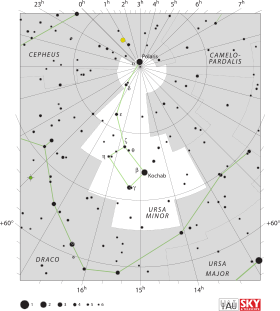Theta Ursae Minoris
(θ UMi)
| Ascension droite | 15h 31m 24,9160s[1] |
|---|---|
| Déclinaison | +77° 20′ 57,7120″[1] |
| Constellation | Petite Ourse |
| Magnitude apparente | 4,982[2] |
Localisation dans la constellation : Petite Ourse | |
| Type spectral | K5-III CN0.5[3] |
|---|---|
| Indice U-B | +1,553[2] |
| Variabilité | suspectée[4] |
| Vitesse radiale | −25,3 ± 0,5 km/s[5] |
|---|---|
| Mouvement propre |
μα = −44,662 mas/a[1] μδ = +6,979 mas/a[1] |
| Parallaxe | 4,552 5 ± 0,154 5 mas[1] |
| Distance | 219,659 5 ± 7,454 7 pc (∼716 al)[1] |
| Magnitude absolue | −2,04[6] |
| Rayon |
73,50+3,20 −0,95 R☉[1] |
|---|---|
| Gravité de surface (log g) | 1,44 ± 0,23[7] |
| Luminosité | 1 172 ± 46 L☉[1] |
| Température | 3 962 ± 36 K[7] |
| Métallicité | +0,18 ± 0,06 [Fe/H][7] |
Désignations
Theta Ursae Minoris (θ Ursae Minoris / θ UMi) est une étoile binaire suspectée de la constellation circumpolaire boréale de la Petite Ourse. Elle est localisée à 716 ± 24 a.l. (∼ 220 pc) de la Terre[1] et elle est visible à l’œil nu avec une magnitude apparente de 5,0[2]. L'étoile se rapproche du Soleil avec une vitesse radiale de −25 km/s[5].
θ Ursae Minoris est une probable binaire spectroscopique avec deux composantes à peu près identiques[9]. Leur spectre combiné indique un type spectral K5-III CN0.5[3], ce qui signifierait normalement une étoile évoluée géante rouge de type K qui monte une légère surabondance en cyanogène dans son atmosphère externe. Son rayon est estimé faire 73,5 fois celui du Soleil[1] et elle rayonne approximativement comme 1172 Soleils[1]. La température effective de son atmosphère externe est de 3 962 K[7].
La photométrie obtenue durant la mission du satellite Hipparcos montre que θ Ursae Minoris varie en luminosité de quelques centièmes de magnitude. Elle a été cataloguée sous la désignation NSV 20342 dans le New Catalogue of Suspected Variable Stars[10].
Notes et références
[modifier | modifier le code]- (en) Cet article est partiellement ou en totalité issu de l’article de Wikipédia en anglais intitulé « Theta Ursae Minoris » (voir la liste des auteurs).
- (en) A. G. A. Brown et al. (Gaia collaboration), « Gaia Data Release 2 : Summary of the contents and survey properties », Astronomy & Astrophysics, vol. 616, , article no A1 (DOI 10.1051/0004-6361/201833051, Bibcode 2018A&A...616A...1G, arXiv 1804.09365). Notice Gaia DR2 pour cette source sur VizieR.
- (en) E. Høg et al., « The Tycho-2 catalogue of the 2.5 million brightest stars », Astronomy and Astrophysics, vol. 355, , p. L27 (DOI 10.1888/0333750888/2862, Bibcode 2000A&A...355L..27H)
- (en) P. C. Keenan et R. C. McNeil, « The Perkins catalog of revised MK types for the cooler stars », The Astrophysical Journal Supplement Series, vol. 71, , p. 245 (DOI 10.1086/191373, Bibcode 1989ApJS...71..245K)
- ↑ (en) M. A. C. Perryman et al., « The Hipparcos Catalogue », Astronomy & Astrophysics, vol. 323, , L49–L52 (Bibcode 1997A&A...323L..49P)
- (en) J. H. J. de Bruijne et A.-C. Eilers, « Radial velocities for the HIPPARCOS-Gaia Hundred-Thousand-Proper-Motion project », Astronomy & Astrophysics, vol. 546, , p. 14 (DOI 10.1051/0004-6361/201219219, Bibcode 2012A&A...546A..61D, arXiv 1208.3048)
- ↑ (en) Ricardo P. Schiavon, « Population Synthesis in the Blue. IV. Accurate Model Predictions for Lick Indices and UBV Colors in Single Stellar Populations », The Astrophysical Journal Supplement Series, vol. 171, no 1, , p. 146–205 (DOI 10.1086/511753, Bibcode 2007ApJS..171..146S, arXiv astro-ph/0611464)
- (en) Ph. Prugniel, I. Vauglin et M. Koleva, « The atmospheric parameters and spectral interpolator for the MILES stars », Astronomy & Astrophysics, vol. 531, , p. 25 (DOI 10.1051/0004-6361/201116769, Bibcode 2011A&A...531A.165P, arXiv 1104.4952)
- ↑ (en) * tet UMi -- Variable Star sur la base de données Simbad du Centre de données astronomiques de Strasbourg.
- ↑ (en) P. P. Eggleton et A. A. Tokovinin, « A catalogue of multiplicity among bright stellar systems », Monthly Notices of the Royal Astronomical Society, vol. 389, no 2, , p. 869–879 (DOI 10.1111/j.1365-2966.2008.13596.x, Bibcode 2008MNRAS.389..869E, arXiv 0806.2878, lire en ligne)
- ↑ (en) N. N. Samus et O. V. Durlevich, « VizieR Online Data Catalog: General Catalogue of Variable Stars (Samus+ 2007-2013) », VizieR On-line Data Catalog: B/gcvs. Originellement publié dans : 2009yCat....102025S, vol. 1, (Bibcode 2009yCat....102025S)
Liens externes
[modifier | modifier le code]- (en) Theta Ursae Minoris sur la base de données Simbad du Centre de données astronomiques de Strasbourg.
